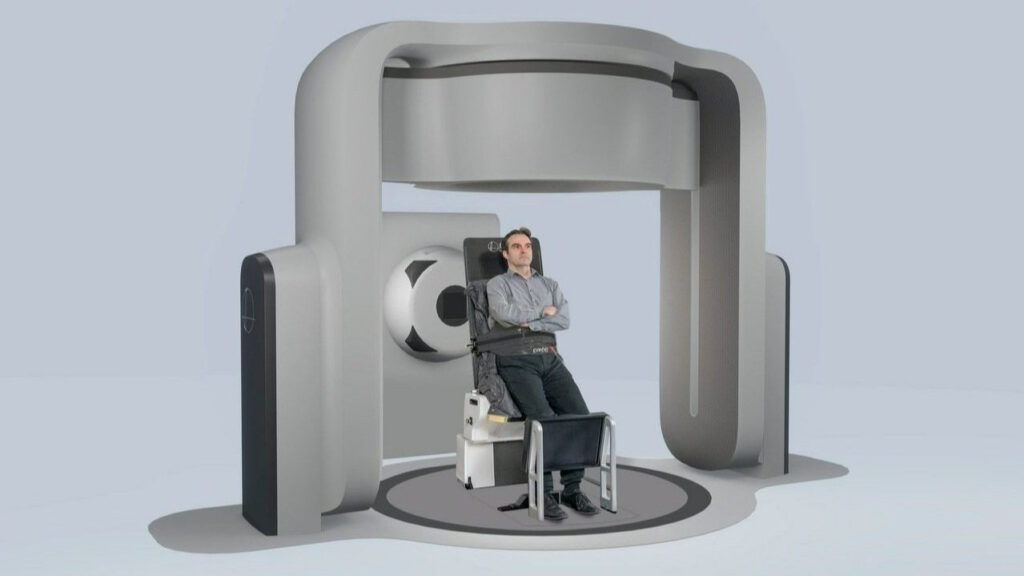Melissa McIntyre, University of South Australia
Upright Imaging & Radiotherapy
Historically, diagnostic imaging of patients is performed in the supine position, despite spending most of their lives standing or sitting upright. Research has revealed significant shifts in the physiology and behaviour of patient anatomy in an upright compared to a supine position. Despite this, there are limited systems available for diagnosing patient conditions in a standing position. While upright MRI exists, it has drawbacks such as longer acquisition times and diminished image quality due to a weaker magnetic field compared to supine MRI. In contrast, upright CT has emerged as a promising alternative, demonstrating comparable image quality to conventional supine CT.
Upright imaging modalities have shown promise in diagnosing conditions that are exacerbated when individuals are standing, such as musculoskeletal and spinal conditions [1, 2]. These modalities have the potential to provide valuable diagnostic information that may be overlooked in traditional supine imaging. Upright imaging can also play a crucial role in arranging anatomy to improve cancer treatment planning. Companies at the forefront of this transformative shift, including LEO Cancer Care [3] and P-Cure [4], are actively working to not only make upright imaging a reality, but also upright radiotherapy, and more specifically, proton therapy.
More cost-effective solution with improved patient comfort and throughput
Proton therapy, known for its conformal, high tumour doses, is an ideal treatment for cases involving abutting critical structures. Development of gantry-less proton therapy treatment systems in an upright position offers numerous advantages, ranging from more cost-effective installation and operation through to a smaller footprint and improved patient comfort [5, 6]. Such systems could even fit inside a generic LINAC suite – a vast improvement on the current footprint of the average proton therapy treatment system. It has been shown that patient comfort is improved, and anxiety lessened when treated in the upright position [5]. Additionally, studies have revealed a reduction in setup times and the magnitude of setup errors, thus improving the quality of treatments and patient throughput [6].
Research has also revealed specific sites for which treatment can be enhanced in the upright position. For instance, when upright, the lung volume increases, thus increasing the distance to surrounding critical structures making lung cancer a good candidate for upright treatment [8, 9]. Similarly, pelvic treatments can benefit in an upright position as shifting of the prostate is not affected by the bladder volume and breathing motion is minimised [6]. Other cancers being assessed for suitability of upright proton therapy treatments include breast, head & neck, and gastrointestinal cancers [4, 10].
Upright diagnostic imaging and proton therapy is an exciting avenue which may allow for better patient comfort during treatments, a reduction of inter-fraction uncertainties, enable lower uncertainty margins and reduced toxicities, higher patient throughput and increased financial accessibility to proton therapy.

References
- Wildermuth S, Zanetti M, Duewell S, et al. “Lumbar spine: quantitative and qualitative assessment of positional (upright flexion and extension) MR imaging and myelography”. Radiology. (1998); 207: pp. 391–398.
- Fielding JR, Griffiths DJ, Versi E, et al. “MR imaging of pelvic floor continence mechanisms in the supine and sitting positions”. AJR Am J Roentgenol. (1998); 171: pp. 1607–1610.
- Leo Cancer Care, https://www.leocancercare.com/ – accessed February 8th, 2024.
- P-Cure, https://www.p-cure.com/ – accessed February 8th, 2024.
- Mackie TR, Towe S, Schreuder N; “Is upright radiotherapy medically and financially better?”. AIP Conf. Proc. (2021); 2348 (1); https://doi.org/10.1063/5.0051770
- Boisbouvier S, Boucaud A, Tanguy R, Grégoire V, “Upright patient positioning for pelvic radiotherapy treatments”. Technical Innovations & Patient Support in Radiation Oncology. (2022), 24: pp. 124-130; https://doi.org/10.1016/j.tipsro.2022.11.003.
- Jinzaki, M et al. “Development of Upright Computed Tomography With Area Detector for Whole-Body Scans: Phantom Study, Efficacy on Workflow, Effect of Gravity on Human Body, and Potential Clinical Impact.” Investigative radiology. (2020); 55(2): pp. 73-83. https://doi.org/ HYPERLINK “https://doi.org/10.1097/RLI.0000000000000603″10.1097/RLI.0000000000000603.
- Yang J, Chu D, Dong L, Court LE. “Advantages of simulating thoracic cancer patients in an upright position”. Pract Radiat Oncol. (2014) 4(1): pp. 53-58, https://doi.org/10.1016/j.prro.2013.04.005.
- Dellamonica J, Lerolle N, Sargentini C, Hubert S, Beduneau G, Di Marco F, Mercat A, Diehl JL, Richard JC, Bernardin G, Brochard L. “Effect of different seated positions on lung volume and oxygenation in acute respiratory distress syndrome”. Intensive Care Med. (2013); 39(6): pp. 1121-7. https://doi.org/ HYPERLINK “https://doi.org/10.1007/s00134-013-2827-x”10.1007/s00134-013-2827-x.
- Boisbouvier S, Underwood T, McNamara J, Probst H. “Upright patient positioning for gantry-free breast radiotherapy: feasibility tests using a robotic chair and specialised bras”. Front Oncol. (2023); 13: pp. 1250678. https://doi.org/ HYPERLINK “https://doi.org/10.3389/fonc.2023.1250678″10.3389/fonc.2023.1250678.
